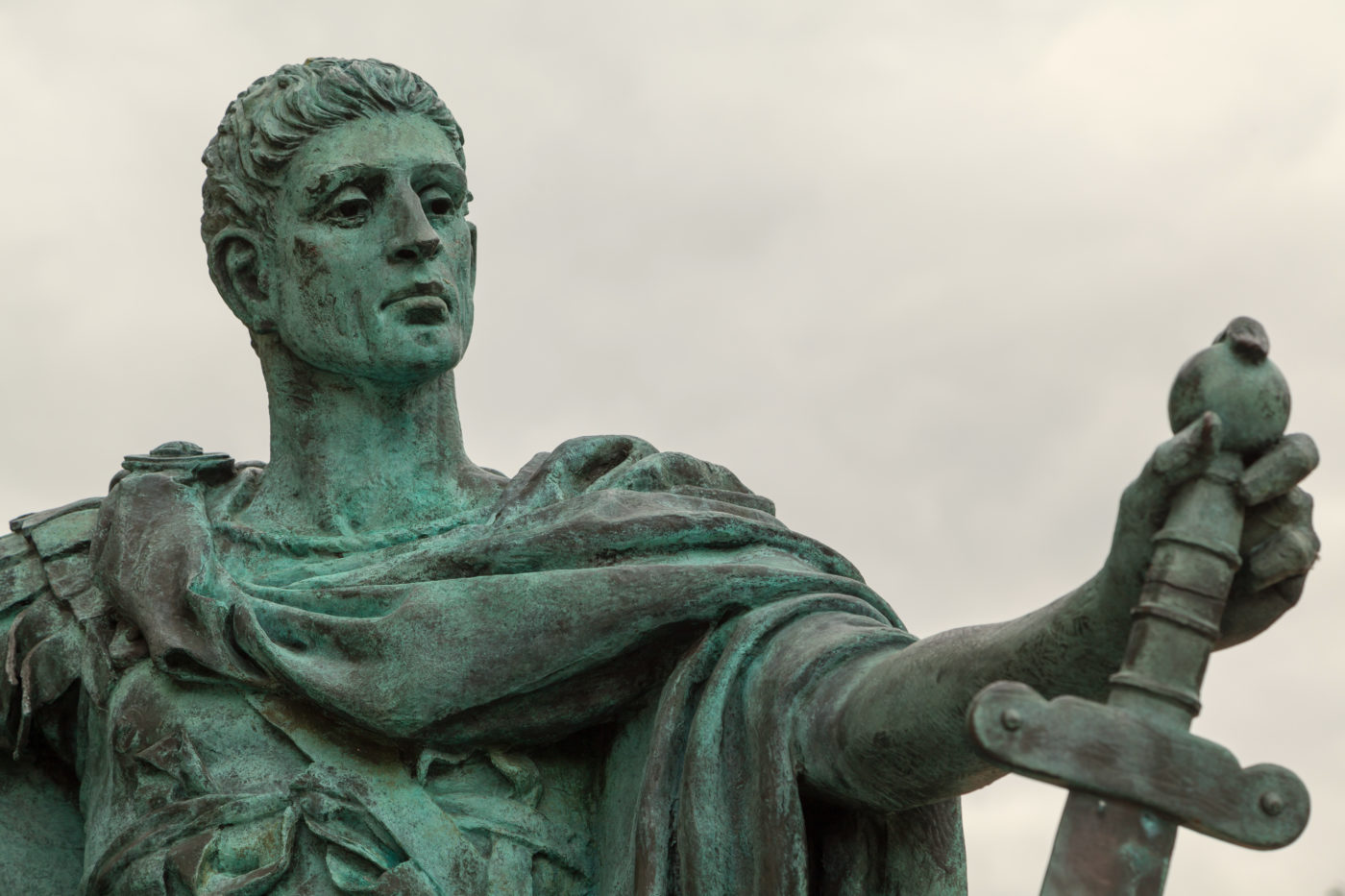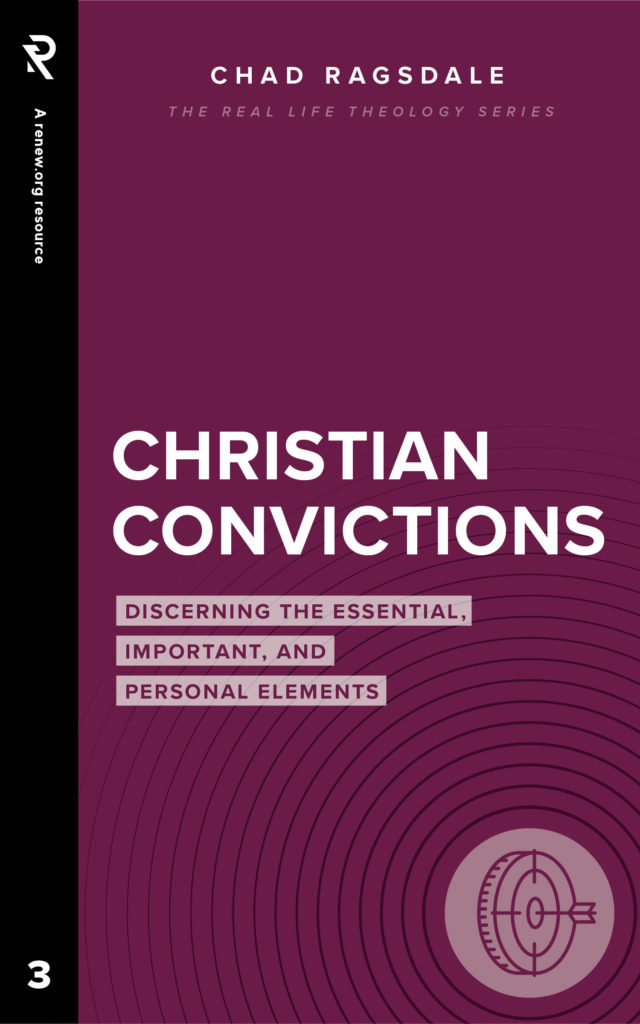
Who’s Constantine the Great? The Story of the Emperor and the Church
Who’s Constantine and what should we think of the relationship between him and the church? Constantine the Great is remembered as the first Christian emperor of Rome. His conversion to Christianity led many Christians to ask for his interventions into church matters. The result was some theological clarity (i.e., the Council of Nicea) as well as a lot of misplaced trust.
The year was AD 303. The Roman military commander Diocletian had been emperor since 284. For almost 20 years, this brilliant leader had been able to stabilize a notoriously ungovernable empire. For he had most intelligently divided the massive Roman Empire into east and west sections, and again split those sections into two, so that each had a junior “Caesar” under a senior “Augustus.” Diocletian named himself Augustus of the eastern half.
Although well on his way to being remembered as one of the greats, Diocletian did something in 303 which forever associates his portrait with villainy. After a period of cautious ease for the Christian church, Diocletian unleashed on them the cruelest persecution they had ever seen. He plucked Christians out of the army. He ordered their church buildings destroyed. He outlawed their worship services. Every scrap of Scripture across the empire was to be burned. Every bishop was to be thrown in prison for torture and possible death.[1] And those were only the first edicts. It was with a later edict that Diocletian brought into clearest possible focus both his intentions and the Christians’ convictions: either sacrifice to the pagan gods or be executed.[2]
“Is there any further hardship Diocletian could have inflicted to get them to stop trusting in God?”
Perhaps this is a fitting moment to reflect. Take the Christians who were executed, some by the sword, others being torn to bits by animals in the center of the amphitheater to sounds of applause and laughter. Wow, they were stubborn. Is there any further hardship Diocletian could have inflicted to get them to stop trusting in God?
Not a chance.
If any suffering had that kind of power over them, they would have buckled at some point a lot sooner along the process. A capitulation would have preceded decapitation. These Christians weren’t going to budge.
“This unmasked evil only confirmed what they had always believed as Christians.”
They obviously trusted in a God who permits tyrants to take away your property and to mutilate your limbs and to enslave your children. And why should they not? After all, this unmasked evil only confirmed what they had always believed as Christians—and what they now were completely sure of—that this world is hideous when it rejects the love of God. Are we to expect that the daily experience of such cruelty would point them to any other conclusion? The tormentors must have felt taunted, as if Christians were asking, “Is that all you’ve got?” It apparently was, and it was not enough.
Beyond Brutality
But the enemy of our souls likes to think outside the barbaric, for if he uses his scary mask all the time, it does not at all have the effect of making him appear trustworthy. Persecution can even provoke fence sitters to their senses, where they mutter things like, “Maybe I ought to make a decision, and I’m not sure I trust the side doing all the killing.” Who knows? Even loyalists to the emperor might have started out trusting in the glory of Rome, but perhaps witnessing and even carrying out such undeserving cruelties could hollow out such trust to where it became mere compliance.
But a change was on its way.
From which direction it blew is difficult to say. Diocletian retired, and he made his fellow Augustus in the West retire too. And just as Diocletian had designed it to work, each Caesar now became Augustus, who would then appoint his own new Caesar. The new Augustus of the West was called Constantius. Constantius had a son named Constantine, with whom we will get acquainted shortly.
Who’s Constantine? “A change was on its way. From which direction it blew is difficult to say.”
Between Diocletian’s retirement in AD 305 and death in AD 311, there were clear signs that his sensible strategy for smooth successions was overly optimistic. There are always those green with envy for not getting picked for Caesar. And, to get a bit more mileage from the metaphor, it turns out that even the ones who do get picked sometimes see the grass as being greener on the other side of the empire. These conflicts came to a head at the Milvian Bridge near Rome in AD 312, where two claimants to the western half of the empire led their armies. One drowned in a river, while the other went on to become western emperor. The latter would take his place among those emperors dubbed “the Great,” but he blazed a new trail for Roman emperors by being prefixed by the church as “Saint.”[3]
His name was Constantine. As Constantine had been preparing for the battle at the bridge, he was purportedly praying to the heavens about noon when a cross appeared in the sky accompanied by the inscription “Conquer by this.”[4] As if that were not confirmation enough, as Constantine slept that night, he received a vision of Christ telling him to use the sign he had seen as a safeguard in battle. So, when he awoke, he had his soldiers’ shields decorated accordingly.[5] They marched into battle and were victorious. The next year, he and his co-emperor in the East signed the Edict of Milan, which gave religious toleration to all faiths, Christian and pagan alike.[6]
Who’s Constantine? “The next year, Constantine and his co-emperor in the East signed the Edict of Milan, which gave religious toleration to all faiths, Christian and pagan alike.”
Since Christians are never told in the Bible to go out looking for persecution, such an edict would appear, even from our contemporary vantage point, to have been a reason for gratitude. The apostle Paul himself urged Christians to pray for kings specifically so that “we may lead a peaceful and quiet life.”[7] It is at some point past that happy historical threshold that things go from good to—very literally—too good to be true. It is not as though everything past that threshold was bad; as a matter of fact, some genuinely wonderful things were to result for society.
How can we be anything but grateful for the care that society’s throwaways finally began to receive as hospitals and orphanages, nursing homes and mental asylums began springing up throughout the Empire in the AD 300s and 400s?[8] Even laws changed for society’s good. For example, infanticide went from being a self-evident solution to something illegal and unthinkable.[9] These and other societal benefits were made possible not only by the absence of persecution, but also by the positive cooperation between the church and state. We do well to admire the pre-Constantine Church, but we shouldn’t romanticize pre-Constantine Roman society before the church began to have the emperor’s ear.
Who’s Constantine? “We do well to admire the pre-Constantine Church, but we shouldn’t romanticize pre-Constantine Roman society before the church began to have the emperor’s ear.”
Constantine the Savior and Constantine the Villain might well be cousins insofar as they are both caricatures. The truth is somewhere in the middle. Yet, whatever the case, the church itself was set for a reverse no less drastic than the imperial policy itself. On the one hand, as their torments had gotten tougher, their trust in God had outfought their temptations in terms of toughness. On the other hand, the more their new privileges fanned out in luxurious display, their fierce trust in God would go on to mellow, slacken, and even redirect when a new object presented itself.
The king frees a maiden from a tyrant. Then, in a sweet plot twist, that king takes a fancy to that maiden and makes her his queen. The first action is enough to make the maiden see him as “great.” After the second, he is forever seen as nothing less than her “saint.”
Who’s Constantine? “Constantine grew ever more obvious in his intentions toward the church.”
After the Edict of Milan, Constantine grew ever more obvious in his intentions toward the church. He courted her at various synods, where he declared how badly he wanted her to be happy and at peace. He gave her back her property, subsidized her ministers, and exempted her from various public duties.[10] And when it was rumored that the eastern emperor was threatening the church,[11] Constantine invaded the East, with the result that Constantine was now supreme emperor over the entire empire. That is what you call a win-win-win. Constantine won, the church won, and Constantine most definitely won the church.
But was it all a win?
The Council of Nicea
After securing the church’s freedom, no gift was as precious to the church as the Council of Nicea. The reason Constantine called the council was a priest from Alexandria, Egypt, named Arius. Arius taught peculiar doctrines about Jesus. According to Arius, God needed a mediator between himself and the world he planned to create. So, before creating the world, God created a spiritual being called the “Word.” And it is through the Word that the world was created.
The Word was the “perfect creature.” But the Word did not possess divinity. What the Word lacked in nature, the Word was able to develop over time. And this Word became flesh. Jesus dwelt among us. And Jesus shows us how we too can grow into perfection as he himself has done.[12] Theologian Adolf von Harnack describes the Jesus of Arius as “an indefinable being that becomes God only in that it becomes man, and that is neither God nor man.”[13] Because of its introduction of another godlike nature into the spiritual, Arianism served as a sort of bridge from monotheism to polytheism, which—questions of heresy aside—was not unattractive in a still-pagan empire.
Who’s Constantine? “Constantine loved unity. After all, he worked hard to bring the entire empire into one fold.”
Constantine loved unity. After all, he worked hard to bring the entire empire into one fold. One empire under one unofficially favored religion is unity at its grandest. That is why Constantine was so troubled when he learned of the disunity Arianism was causing in the eastern half of the empire. Arius’s local bishop had already excommunicated him, but Arius kept his excommunication productive by writing letters and gaining support for Arianism from other bishops, especially in Asia. Constantine felt the sinking sensation that his instrument of imperial unity had become bitterly divided. So he wrote a single letter to both Arius and the bishop that had excommunicated Arius: “Give me back my quiet days and carefree nights. Do not let me spend the rest of my days joylessly.”[14]
When the letter turned out not to be the adhesive he had hoped it would be, Constantine called a council of the entire church. The summons drew 318 bishops. Initially only 17 stood with Arius, and by the end there were 2.[15] The church leaders created a Creed (the Nicene Creed) in which Jesus was recognized as being of the same nature as the Father. Constantine was elated to find the bishops so unified. And, for the moment, bishop and emperor found themselves strolling hand-in-hand, neither having to pull away out of suspicion that the other was tightening their grip too hard. Their interests happily coincided.
After the Honeymoon
Typically, romances between two powerhouses proceed only as smoothly as the interests of both are being furthered. It was in the church’s interests that its leadership had made a clear statement that Jesus’ divinity was an essential of their faith. Yet there remained Arian dissenters in the church. Arianism refused to curl up and die. Arians continued persuading Christians toward their cause with limited success. And since any brand of Christianity that minimizes the distinctiveness of Jesus is always more amenable to religious syncretism, Arianism was able to win sympathy from Jews and pagans.[16] Still, the church as a whole had made it clear that they were Nicene, and the popular growth that Arianism enjoyed would not overturn the church’s collective stand.
Who’s Constantine? “Although Constantine had not overturned orthodoxy, he had shown how it could be done.”
But there was an emerging way in which Arianism could win the church without having to exponentially increase conversions. Although Constantine had not overturned orthodoxy—instead being pleased to be able to officially recognize the consensus already there—Constantine had shown how it could be done. Constantine himself gradually softened toward the Arians, but it was his son Constantius who actually became one. Constantine had arranged that, after his death, his empire would be ruled by his three sons. Yet it was Constantius, seizing the entire empire from the brothers he was meant to share it with, who used the state to overturn the Nicene consensus by force and foist Arianism on the empire.
It’s not unsurprising that an emperor would prefer a version of Christianity based on a man who became God, especially since only a generation had passed since emperors themselves were proclaimed divine.[17] Whatever his reasons, Constantius was insistent that Arianism be made the imperial religion. He appointed his own bishops and called his own synods where he imposed the insertion of a single letter to make homoousia (of same nature) say homoiousia (of like nature): Jesus’ nature was only like that of God.[18] He knew he would need to get rid Athanasius, the loudest champion of Nicene Christianity, and so he called a gathering of bishops to condemn Athanasius. While the bishops argued among themselves, Constantius, who had apparently been hiding behind a curtain, emerged with his sword. “This is against the canon!” some protested, to which he replied, “I am the canon.”[19]
“This is against the canon!” some protested, to which Constantius replied, “I am the canon.”
The church had made a wrong turn, and she was beginning to realize it. Himself exiled five times, Athanasius lamented, “When did a judgment of the church receive its validity from the Emperor?”[20] It was becoming clear that the church had been devolving into a department of the state, something under quiet construction in Constantine’s time.[21] The good news is that Nicene Christianity eventually reemerged on top to stay, four emperors after Constantius, while the interim saw an imperial resurgence of paganism and then of Arianism. But even when imperial favor returned to rest on the church leaders’ original consensus, full circle still left the church beyond a forgotten threshold. We only have to consider the victorious Nicene emperor Gratian’s decision to execute a heretic involved in magic.[22]
Why give your permission?
Perhaps it was accepting the emperor’s special honors. Perhaps it was letting the emperor call councils and authorize creeds. Or perhaps it was his ability to appoint and depose bishops. Or perhaps it was his persecution of the church’s enemies. At some point, it occurs to the student of church history that the church made a wrong turn, or perhaps it is better to say the church permitted a wrong turn, allowing itself to be led somewhere her conscience should have protested. Precisely what that initial wrong turn was is up for debate. Whatever the wrong turn was, why did the church take it? At least four reasons can be given for why the church welcomed Constantine’s benevolent oversight.
4 Reasons the Church Welcomed Constantine’s Oversight
First, there was the unpleasant alternative. When the only other alternative in recent memory is a destroyer like Diocletian, it makes good sense to go along with an emperor who declares and demonstrates his favor.
Second, there were the unmistakable benefits. As already mentioned, not only did the arrangement grant to the church benefits that they recognized back then, but it also gave to society many blessings we recognize today. It was largely because of Christianity’s influence with the state that women were given more rights, slaves were accorded better treatment, and gladiatorial games were outlawed.[23]
Third, there were the unresolved conflicts. Leaders of Christian factions saw the opportunity to get the upper hand, and they often asked the emperor to intervene on their behalf.[24]
“Leaders of Christian factions saw the opportunity to get the upper hand, and they often asked the emperor to intervene on their behalf.”
Fourth, there was the unforeseen dispensation. Suddenly, it appeared that God had brought upon them a glorious new era. The Bible had promised, after all, the coming of the kingdom. And though Christians did not put the Second Coming of Christ out of mind, they were able to push it back into a corner. For here was an emperor whose admitted ambition was to encourage all nations to know Christ.[25] To many Christians, it was only natural to assume that God had brought history through its dark ages to an epoch where Christianity reigned in grand finale. This was the view of no less than the most learned Christian of the day, the church historian Eusebius, and though he clearly miscalculated, it is difficult to see exactly where a more careful Eusebius would have clearly spotted the miscalculation.[26]
However understandable the church’s decisions during the Constantine years, it is important to remember that, at some point past a shadowy and slippery threshold, it became clear that at least some wrong turns were made, mistakes from which we should be willing to learn. One lesson is immediately clear: The more political power the church wins, the more it begins trusting in that power.
“The more political power the church wins, the more it begins trusting in that power.”
When asked to bow to somebody besides God in exchange for receiving the earthly kingdoms, Jesus’ reply seems a fitting way to close out this article about the Constantine years: “Worship the Lord your God, and serve him only” (Matt. 4:10).
[1] Bruce L. Shelley, Church History in Plain Language, 2nd ed. (Nashville: Thomas Nelson Publishers, 1995), 93.
[2] Earle E. Cairns, Christianity through the Centuries: a History of the Christian Church (Grand Rapids: Academie Books, 1981), 93.
[3] “St. Constantine the Great,” accessed August 15, 2015, http://www.catholic.org/saints/saint.php?saint_id=2731.
[4] Eusebius, “Chapter 28,” Life of Constantine: Book I, trans. Ernest Cushing Richardson, from Nicene and Post-Nicene Fathers, Second Series, vol. 1, ed. Philip Schaff and Henry Wace (Buffalo: Christian Literature Publishing, 1890), ed. for New Advent by Kevin Knight, http://www.newadvent.org/fathers/25021.htm.
[5] Eusebius, “Chapter 29,” Life of Constantine: Book I.
[6] Richard A. Todd, “Constantine and the Christian Empire,” in Introduction to the History of Christianity, ed. Tim Dowley (Minneapolis: Fortress Press, 2002), 146.
[7] I Tim. 2:2 ESV.
[8] Alvin J. Schmidt, How Christianity Changed the World (Grand Rapids: Zondervan, 2004), 145.
[10] Constantine, “Constantine’s Support of the Church,” in Documents of the Christian Church, 3rd ed., ed. Henry Bettenson and Chris Maunder (Oxford: Oxford University Press, 1999), 18-20.
[11] Eusebius, “Chapter 52,” Life of Constantine: Book I.
[12] Harold O.J. Brown, Heresies: Heresy and Orthodoxy in the History of the Church (Peabody: Hendrickson, 2000), 114-115.
[13] Adolf von Harnack, quoted in Brown, 116.
[15] Jonathan Hill, Zondervan Handbook to the History of Christianity (Grand Rapids: Zondervan, 2006), 80-81.
[16] Brown, 118.
[19] Hill, 84.
[22] Todd, 151.
[25] Eusebius, “Chapter 65,” Life of Constantine: Book II, trans. Ernest Cushing Richardson, from Nicene and Post-Nicene Fathers, Second Series, vol. 1, ed. Philip Schaff and Henry Wace (Buffalo: Christian Literature Publishing, 1890), ed. for New Advent by Kevin Knight, http://www.newadvent.org/fathers/25022.htm.
[26] Justo L. Gonzalez, The Story of Christian: the Early Church to the Dawn of the Reformation, vol. 1 (New York: HarperOne, 2014), Kindle edition.








